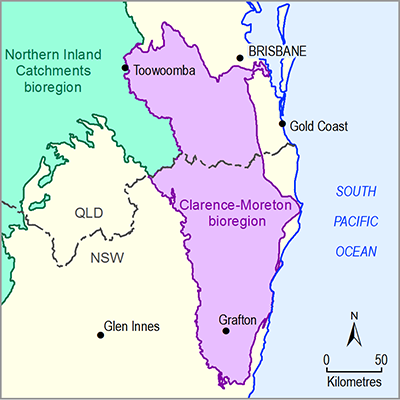The observed water chemistry and quality data for the Clarence-Moreton bioregion are sourced primarily from the Queensland and NSW state groundwater databases.
In the Queensland database, 5854 water chemistry sampling records exist for the Clarence-Moreton bioregion, with the earliest sampling record dating back to 1919. Each record relates to an individual sampling event, conducted on 1 of 2509 bores. The breadth of bore data is variable. Multiple measurements (time series data) exist for some bores: 320 bores within the Clarence-Moreton bioregion in Queensland have more than five water chemistry records, and one bore in the Lockyer Valley has been sampled 18 times for water chemistry. In contrast, only very few groundwater bores with multiple water chemistry records exist in the Clarence-Moreton bioregion in NSW.
The overall quality of the chemistry data is highly variable. For example, potassium was generally not measured in water chemistry analyses prior to 1975. Additionally, CBE, which are considered to be an indicator of the data quality of major ion analyses, are also highly variable. Due to quality concerns with older water chemistry records, only water chemistry records collected after 1980 were used.
After an extensive screening process, 3183 out of a total of 5854 individual sampling records (corresponding to 54%) were considered suitable for multivariate statistical analysis in the Clarence-Moreton bioregion in Queensland. Most (66%) are samples collected from the alluvial aquifers in the Lockyer Valley, the Warrill creek catchment and Bremer and Logan-Albert river basins (Table 13). The bedrock stratigraphic unit with the largest number of water chemistry sampling records is the Woogaroo Subgroup (approximately 5% of all sampling records), followed by the Gatton Sandstone (the lower member of the Marburg Subgroup).
Table 13 Number of water chemistry records for the Clarence-Moreton bioregion in the Queensland and New South Wales databases that meet the quality requirements for the multivariate statistical analysis
NP* denotes stratigraphic units that are not present in Queensland.
Data: Bioregional Assessment Programme (Dataset 10, Dataset 19)
The NGIS groundwater database (Bureau of Meteorology, Dataset 1) contains 1201 water chemistry sampling records from 657 groundwater bores across the Clarence-Moreton bioregion in NSW. After quality checks (including calculation of CBE, and assessment of bore construction details), only 570 of these records (approximately 47%) were considered suitable for multivariate statistics (Table 13). The hydrostratigraphic units in which the bores in the Clarence-Moreton bioregion in NSW are screened are only known for nine bores, therefore the attribution to hydrostratigraphic units (Table 13) is based on our own assessment as outlined in Section 2.1.3.1.1. If major ions or other parameters were missing, but electrical conductivity measurements existed, then these measurements were used for the assessment of the spatial patterns of electrical conductivity.

Product Finalisation date
- 2.1.1 Geography
- 2.1.2 Geology
- 2.1.2.1 Methods
- 2.1.2.2 Observed data
- 2.1.2.3 Statistical analysis and interpolation
- 2.1.2.3.1 Three-dimensional geological model workflow
- 2.1.2.3.2 Definition of the stratigraphic column
- 2.1.2.3.3 Selection of input datasets
- 2.1.2.3.4 Representation of structural elements in the three-dimensional geological model
- 2.1.2.3.5 Characterisation of binding horizons of shallow aquifers (alluvium and basalt)
- 2.1.2.3.6 Characterisation of the bedrock stratigraphic units in the Clarence-Moreton bioregion
- 2.1.2.3.7 Isopach maps, depth to formation top and depth to base of formation
- 2.1.2.4 Gaps
- References
- Datasets
- 2.1.3 Hydrogeology and groundwater quality
- 2.1.4 Surface water hydrology and water quality
- 2.1.5 Surface water – groundwater interactions
- 2.1.6 Water management for coal resource developments
- Glossary
- Citation
- Acknowledgements
- Contributors to the Technical Programme
- About this technical product
